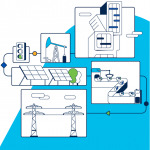Cars in constant conversation with road sensors. Autonomous vehicles. Progress toward zero emissions. These are just a few highlights of digital transformation showcased at Cisco Live, held June 12-16, 2022. I and my fellow attendees—in person and virtual—were treated to example after example of “wow” experiences both here today and coming tomorrow – all powered by data. These experiences are based using the network as a “digital nervous system.” It senses by connecting cameras, IoT sensors and systems. It transmits this sensed data to the brain (applications at the edge or cloud). And it delivers amazing experiences back out to us humans. Here are a few of my favorite examples from Cisco Live on how digital transformation will create new possibilities.
New business models
We heard from Jim Farley, President and CEO of Ford Motor Company and Darren Palmer, Vice President of Electric Vehicle Programs for Ford Model e. Both Farley and Palmer talked about how Ford is transforming the customer relationship from discrete events to something that happens every day. “Imagine a world where vehicles get data from a network of sensors,” Palmer said. “They’re embedded in the roadways or the intersections, even buried within the concrete … This digital transformation stands to completely change the relationship with our customers, redefining our business model, and giving us a path to the future. The network is key to help make this 20-year vision a reality.”
Safer roads and cities
We heard more about the role of IoT data in transportation safety from Tim Slusser, Chief of Mobility Innovation for the City of Detroit. Pointing out that for every accident there are many more near misses, he said, “Having access to and sharing real-time data will let our citizens know when and where these hazards and risks exist. And it will let us predict and possibly prevent them in the future. This could not only change the way that cities and roads are run, it could positively impact the environment, congestion, and ultimately it will help save lives.”
We saw the possibility of what a “network of sensors” means in various Cisco Live demos. In one demo, a car received an alert when a pedestrian stepped into an upcoming crosswalk. In another, an ambulance overrode normal traffic light timing to create a “green corridor,” saving precious minutes.
Improved efficiencies and customer experiences via a “Rolling data center”
Many attendees flocked to the session on “Extending Wireless and 5G to Next-Generation Buses,” with Central Ohio Transit Authority (COTA) of Columbus, Ohio. Organizations like COTA are connecting their buses to the network to collect telemetry information (say, for predictive maintenance) and to attract riders with reliable Wi-Fi. But progress has been limited because bus mechanics generally aren’t trained in installing and maintaining wireless gateways. COTA overcame that problem with Cisco industrial gateways. Through the Cisco IoT Operations Dashboard, the process of installing and integrating the routers on the bus has evolved. Technicians install the router, power it up, and through Plug and Play the router reaches out to the Operations Dashboard for automated configuration. Additionally, as cyber security continues to become crucial to businesses in all sectors, COTA will leverage technologies such as Cisco Cyber Vision to protect against today’s and tomorrow’s cyberthreats. “We have created a rolling data center and finally integrated the operational technology and IT experience,” said Sophia Mohr, COTA’s Chief Innovation and Technology Officer.
Chain reaction across industries
One industry’s digital transformation can be so significant that it can cause chain reactions across adjacent industries, bringing even more benefits. Autonomous vehicles, as an example, could also mean changes to the insurance industry, to first responders, and suppliers to name a few. And those are just the transportation examples. Similar stories of digital transformation are happening in utilities, mining, manufacturing, ports, and other industries.
Imagining the possibilities
We can’t even pretend to imagine all the ways that data will change our lives for the better. Some applications my team has been exploring include new business models based on software as a service (SaaS). Improving safety by detecting problems (machine problems, road hazards) and taking action before harm occurs. Realizing zero emissions by reducing congestion and time on the road. And increasing efficiencies with better insights and autonomous operations. The common theme in all of these innovations is the network—the digital nervous system working behind the scenes to sense information, move it up to the cloud or out to the edge, and deliver great experiences back to the people.
Check out how Cisco’s IoT portfolio brings together the industrial network, data, and security to deliver our next generation experiences.
How has data changed your company or industry over the last three years? How do you expect it to change over the next five? We’d love to hear from you – drop us a line in the comments below.

CONNECT WITH US